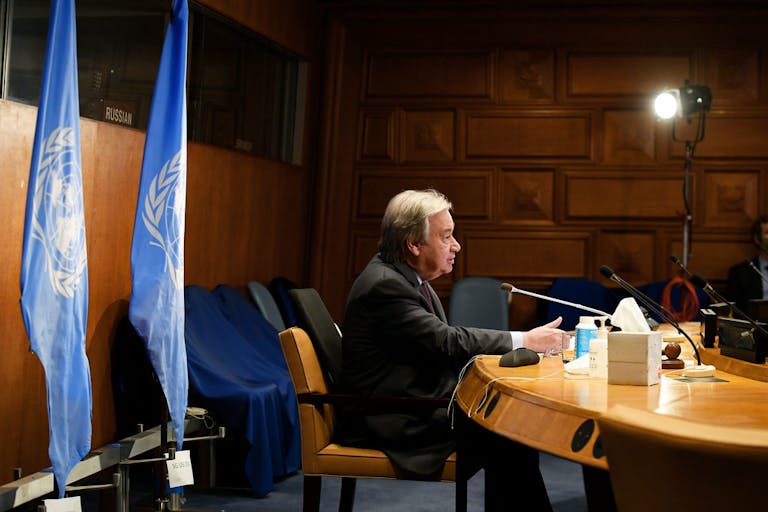On Earth Day 2021, the U.S. administration hosted the Leaders Summit on Climate, convening more than 40 world leaders to meet the challenge of climate change. Major commitments on climate were made by the U.S. and other countries to limit greenhouse gas emissions, advance ocean-based solutions, invest in sustainable agriculture, support nature-based solutions, and scale up climate finance. These commitments represent an opportunity for bold global leadership on climate and now must be translated into concrete action.

The Leaders Summit on Climate successfully signaled renewed U.S. global engagement on climate and a willingness to act decisively on the issue. In convening this dedicated climate summit at the head-of-state level, President Joe Biden elevated the issue and succeeded in engaging a broad swath of leaders from across the globe. He put forth an ambitious U.S. climate target, pledging to cut greenhouse gas emissions by 50-52% by 2030 compared with 2005 levels — a goal that will put the economy on track to reach net-zero emissions by 2050.
The new goal not only put the U.S. among the top four most ambitious near-term climate commitments in the world, but it also successfully mobilized new targets from other countries:
- Japan nearly doubled its emissions reduction target, aiming for a minimum of 46% cut by 2030, compared with 2013 levels.
- South Korea declared its intention to strengthen its nationally determined contribution (NDC) before the UN Climate Change Conference (COP26) in Glasgow and to end all public financing for new coal plants abroad — a significant step for the world’s third-largest public financier of coal after China and Japan.
- Canada announced an enhanced NDC of 40-45% below 2005 levels by 2030.
- While met with some skepticism given President Jair Messias Bolsonaro’s poor track record on climate and environmental issues, Brazil committed to carbon neutrality by 2050.
It is estimated that the so-called carbon gap between what countries have pledged and what is required to stay on a course with the Paris Agreement was closed by approximately 12-14%, based on commitments declared between September of last year and the Leaders Summit — a meaningful advancement for global climate action, even as much work remains.
But while the enhanced economywide emission reduction targets and goals grabbed most headlines, several new sectoral and financial initiatives also emerged from the summit, all of which will be critical to help countries meet their near- and long-term climate goals and require further action that we will be tracking at key moments over the remainder of the year. Here are a few:
Advancing ocean-based climate solutions
The world’s ocean consists of a variety of marine habitats that provide livelihoods for more than 3 billion people around the world. With the potential to contribute about a fifth of the emission cuts needed to reach the goals of the Paris Agreement, countries are increasingly turning to the ocean as a critical source of climate mitigation. To date, 40 countries have included ocean-based climate solutions in their climate targets — and the summit marked growing momentum in solutions such as reducing emissions from marine transport and conserving “blue carbon” ecosystems.

Prior to the summit, leaders from around the globe participated in How Ocean-Based Solutions Contribute to Net Zero, a virtual event hosted by the countries of the Friends of the Ocean and Climate and organized by Ocean Conservancy and the UN Foundation. At the event, the U.S. and Belgium committed to work with countries in the International Maritime Organization (IMO) to achieve zero emissions from shipping by 2050. If this were to become a formal IMO target, it would be significantly more ambitious than IMO’s current goal to halve emissions by 2050 compared with 2008 levels. The Marshall Islands noted its ambitious proposal at the IMO and challenged the world to act while also pledging to transform its domestic fleet toward low carbon technology. Reinforcing the need to reduce shipping emissions, Norway has established a target to cut emissions from domestic shipping and fishing by 50% by 2030 while Japan is developing the first-ever commercial-ready oceangoing zero-emissions ship. During the Leaders Summit, Denmark announced a collaboration under Mission Innovation, a new project that will use technology to address decarbonization of the global shipping sector.
In addition, the U.S., UK, and Belgium noted commitments to build out offshore wind energy, while Hawaii emphasized the potential of wave and ocean thermal energy as well as offshore wind as critical to reaching its goal of 100% renewable power by 2045. Costa Rica and Seychelles demonstrated their commitment to protecting blue carbon ecosystems. The U.S. committed to supporting Southern Ocean marine protection proposals to tackle climate change in Antarctic and announced increased engagement with and support for island nations around climate issues. These announcements highlight the critical role of the ocean in climate mitigation and adaptation in achieving, while also protecting, vital ocean resources.
Investing in agricultural research and development
Although the global food system is responsible for a third of global emissions and is one of the most vulnerable sectors to its impacts, it has been largely overlooked as a source of climate mitigation. The summit highlighted that this is about to change. The United States and the United Arab Emirates announced that they will lead a new initiative, Agriculture Innovation Mission for Climate, to accelerate global agricultural innovation and research and development (R&D) over the next five years to address climate change.
Agricultural R&D can help farmers grow more food on less land while using fewer chemicals, thereby reducing greenhouse gas emissions. Innovation, including the development of new drought and flood resistant varieties, can also make farms more resilient. But despite the many climate benefits — and co-benefits such as lower global food prices and increased food security — agricultural R&D is chronically underfunded in many countries. The Agriculture Innovation Mission for Climate and other emerging coalitions can move the needle on this critical issue, accelerating the much-needed transition in how we produce, consume, and transport food. The initiative, supported by the UK, Brazil, Denmark, Israel, Singapore, Australia, and Uruguay, will be advanced at the UN Food Systems Summit in September and launched at COP26 in November.
Putting nature-based solutions at the heart of global climate action
So-called nature-based solutions can provide up to 37% of the emission reductions needed to curb global temperature increases by 2030. To help realize this potential, among other critical benefits, U.S. Agriculture Secretary Tom Vilsack reaffirmed the Biden administration’s goal of protecting at least 30% of America’s lands and ocean by 2030. During the ocean/climate event, leaders and top government officials from countries as diverse as Fiji, Chile, and Belgium also voiced their support for an analogous global “30×30” protection goal — a target they are hoping will be enshrined at the next UN Biodiversity Conference in October. Relatedly, the U.S. announced that it will make available new financial resources to implement nature-based solutions. One example is the Lowering Emissions by Accelerating Forest finance (LEAF) Coalition. This public-private effort by the U.S., UK, Norway, Amazon, Nestle, and others will seek to mobilize more than $1 billion this year to incentivize reducing emissions in tropical and subtropical countries.
Aligning financial flows with the Paris Agreement and scaling up climate finance
An increasing number of financial institutions are now committed to setting the course for a net-zero economy by 2050. The Glasgow Financial Alliance for Net Zero (GFANZ), launched just before the summit, brings together over 160 firms responsible for over $70 trillion worth of assets committed to accelerating climate action. The alliance, chaired by Mark Carney, the UN Special Envoy on Climate Action and Finance, includes the Net Zero Asset Managers initiative and the Net Zero Asset Owner Alliance as well as a new Net Zero Banking Alliance of 43 members, convened by the United Nations Environment Programme Finance Initiative (UNEP FI).

In terms of public finance, the main outcome of the summit came from the U.S.: Mr. Biden pledged to double public funding by 2024 to about $5.7 billion per year to help developing countries reduce greenhouse gas emissions and adapt to the impacts of climate change. As part of this commitment, the U.S. will also triple its climate adaptation financing by 2024, bringing it to $1.5 billion per year. Although this indicates a radical shift from the previous administration, experts consider the U.S. still has a long way to go to equate the leadership demonstrated by some European Union (EU) countries. Mr. Biden also called for an end to fossil fuel subsidies and vowed to take steps to incorporate climate risk into the financial system.
While the administration has presented its FY22 budget request, that is just the start of a longer process until Congress passes a budget likely late in 2021. At this stage the White House has been asking Congress to appropriate $1.25 billion to the Green Climate Fund, covering more than 60% of U.S. arrears. As we approach the UN Climate Change Conference in Glasgow, we will be watching how the U.S. leadership is able to drive substantial movement on international climate finance mobilization, green recovery, and debt alleviation at the next G7 and G20 meetings ahead of COP26, recognizing that such efforts, or lack thereof, would set the stage for success in Glasgow.
Toward a successful UN Climate Change Conference in Glasgow
As Mr. Biden stressed during the Leaders Summit, the world faces a “moment of peril” but also a “moment of extraordinary possibilities.” Indeed, the summit marked the beginning of a new phase in global climate politics — one where the U.S. once again has the opportunity to drive action both domestically and around the globe. But commitments are not enough. To meet the challenge of climate change and make this the “decade of transformation,” they must be translated into “concrete, immediate action,” UN Secretary-General António Guterres said at the summit. From the UN Food Systems Summit in September to the UN Biodiversity Conference in October, the international calendar offers several new opportunities to galvanize further action and mobilize additional resources in support of these emerging initiatives in the lead-up to the UN Climate Conference Change Conference in Glasgow.
Featured Photo: Adam Schultz/ White House



 View All Blog Posts
View All Blog Posts


